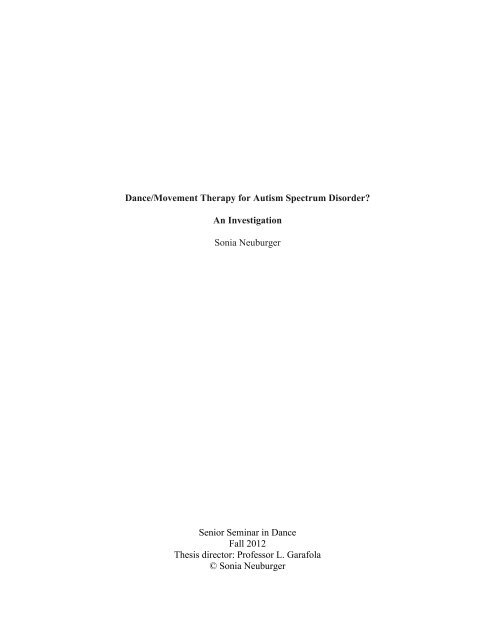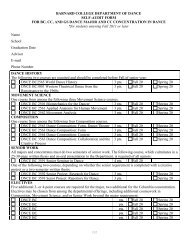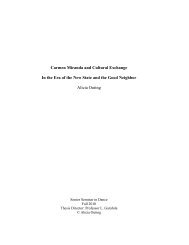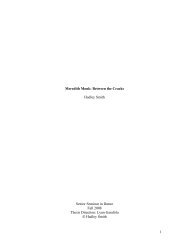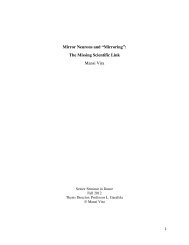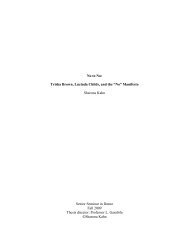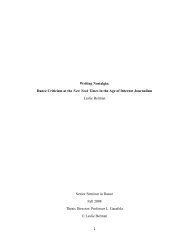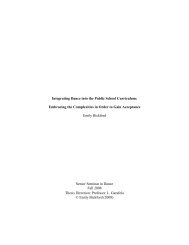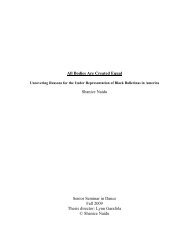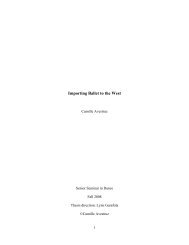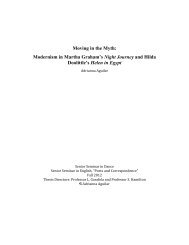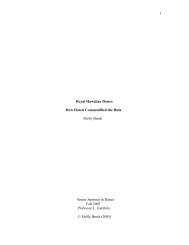By Sonia Neuburger - Dance - Barnard College
By Sonia Neuburger - Dance - Barnard College
By Sonia Neuburger - Dance - Barnard College
You also want an ePaper? Increase the reach of your titles
YUMPU automatically turns print PDFs into web optimized ePapers that Google loves.
<strong>Dance</strong>/Movement Therapy for Autism Spectrum Disorder?<br />
An Investigation<br />
<strong>Sonia</strong> <strong>Neuburger</strong><br />
Senior Seminar in <strong>Dance</strong><br />
Fall 2012<br />
Thesis director: Professor L. Garafola<br />
© <strong>Sonia</strong> <strong>Neuburger</strong>
As a student who struggles to balance my love of dancing, education, and the<br />
sciences (especially chemistry), I have traveled a winding path through departments and<br />
mindsets at <strong>Barnard</strong> <strong>College</strong>. A course about special education during my semester<br />
abroad in Copenhagen, Denmark, piqued my interest in education for children with<br />
special needs, and while there I studied with people who brought dance/movement<br />
therapy (DMT) to my attention. So perhaps it was inevitable that my thesis topic would<br />
come to combine all of these interests.<br />
Autism has always fascinated me, probably due to a combination of influences:<br />
my young cousin was diagnosed with autism; a close family friend works at a school for<br />
autistic children, and I have a powerful childhood memory of seeing a play about an<br />
autistic teenager. Studying in Copenhagen with a woman who specializes in autism<br />
brought my latent interest in the disorder to the forefront. To write my senior thesis on<br />
dance/movement therapy as it relates to autism seemed only natural.<br />
The American <strong>Dance</strong> Therapy Association’s website includes a long list of<br />
unpublished master’s theses about DMT and autism, and once I saw that wealth of<br />
available resources, I knew I had found my topic: I would combine dance, special<br />
education, and the science of discovering the cause, diagnosis, treatment, and cure for<br />
autism.<br />
1
When I emailed my family friend, who has worked with autistic children for three<br />
decades, to ask her thoughts on this topic, I was excited, even hopeful. I was imagining<br />
that research into DMT and autism would show a great potential for dance as a means of<br />
communication (something autistic children struggle with). Her response stopped me in<br />
my tracks. She wrote that dance/movement therapy is not a treatment for autistic<br />
children, that it is “bad science,” and that while “it's becoming a priority for us [educators<br />
at her school] to learn how to teach art and music and dance to our students … that has to<br />
be distinguished from seeing these activities as a kind of therapy.” 1<br />
This skepticism, from someone I and countless others trust as an experienced<br />
professional working with autistic children meant that I had to look critically at the case<br />
studies and other materials I had found. I drew on my scientific background and my<br />
belief in numbers to sift through and analyze the studies. Taking into account who wrote<br />
a study, when it was written, what exactly it was saying, and how it accounted for the<br />
nature of autism, I arrived at a question I had barely encountered in my research. Should<br />
dance be used as therapy for children with autism spectrum disorder?<br />
Autism spectrum disorder is a neurodevelopmental disorder that involves<br />
problems in communication, social interaction, narrow interests, and repetitive behaviors.<br />
The disorder is a spectrum, meaning people with autism have a vast range of symptoms<br />
and behaviors associated with the disorder. 2 A very effective, well-known treatment<br />
approach for people with autism is called Applied Behavior Analysis (ABA). In general,<br />
ABA is a method of teaching skills and behaviors to people with autism by breaking<br />
tasks down into very small, sequential steps. ABA relies on the idea that behaviors are<br />
1 Susan Langer (snlanger@gmail.com), personal communication with the author, 5 October 2012.<br />
2 Joel D. Bregman, “Definitions and Characteristics of the Spectrum,” in Autism Spectrum<br />
Disorders, 3d ed., ed. Dianne Zager (Mahwah, N.J.: Lawrence Erlbaum Associates, 2005), 7.<br />
2
spurred by a person’s environment. 3 These two topics will be explained in more detail<br />
below.<br />
All people, whether on the autism spectrum or not, can benefit from<br />
dance/movement therapy. However, DMT is only appropriate for a specific subset of<br />
children with autism. Because the behaviors and symptoms of autism range across an<br />
enormous spectrum, and because there is minimal evidence of DMT’s efficacy, DMT is<br />
not regarded as an effective treatment, unlike Applied Behavior Analysis. The challenges<br />
DMT has encountered in its research additionally hinder its acceptance by professionals<br />
in the world of autism. Instead of being used as a therapy, I believe that the dance aspect<br />
of DMT can be a refreshing, fulfilling activity for children on the autism spectrum, not<br />
because it will change behaviors, but because it offers a positive, enjoyable life<br />
experience.<br />
Review of Literature and Methodology<br />
A wide range of literature exists pertaining to DMT and autism spectrum disorder.<br />
This includes chapters from books about creative arts therapies, journal articles, master’s<br />
essays, and Ph.D. dissertations that document and describe case studies using DMT with<br />
autistic children. Written in a mostly qualitative manner by dance/movement therapists,<br />
these case studies were published from 1978 to the present and usually describe positive<br />
results. I read more scientific journal articles from Research in Autism Spectrum<br />
Disorders and The Arts in Psychotherapy, written by scientists about specific DMT<br />
methods and research in exercise for autistic children. I also examined books focusing<br />
3 Langer communication.<br />
3
specifically on autism spectrum disorder or dance/movement therapy, and a book and<br />
articles about research methods, problems, and attitudes in dance/movement therapy.<br />
I have conducted a few informal interviews. I spoke at length with Deb Gordon, a<br />
cousin and the mother of a ten-year-old autistic boy, about any DMT or exercise/physical<br />
therapy her son may have had, why she enrolled him in those therapies, and what the<br />
goals and results have been. 4 I also interviewed Susan Langer, a behavior analyst and the<br />
Chief Program Officer at the New England Center for Children (NECC), a renowned<br />
research and education center for autistic children in Southborough, Massachusetts. I<br />
questioned her about her personal views with respect to DMT for autistic children,<br />
NECC’s stance on DMT, Applied Behavior Analysis, NECC’s use of dance, and general<br />
physical exercise for their students.<br />
Langer views dance/movement therapy as an intervention without sufficient<br />
evidence of its efficacy, and therefore does not use or recommend it to her students.<br />
NECC, she says, is “very strongly committed to empirically based interventions,” which<br />
DMT is not. 5 The lens of this paper will use her rigorous, scientifically-based perspective,<br />
as well as literature that exposes problems with DMT research, to critique case studies<br />
and assess whether or not dance should be used as a therapy for children with autism<br />
spectrum disorder.<br />
Background<br />
<strong>Dance</strong>/Movement Therapy (DMT)<br />
<strong>Dance</strong>/movement therapy has been used in the United States since World War II.<br />
Marian Chace, a dancer with the Denishawn company, choreographer, and teacher of<br />
4 Deb Gordon (dgs@comcast.net), personal communication with the author, 27 September 2012.<br />
5 Langer communication.<br />
4
modern dance in Washington D.C. during the 1930s and 1940s, first developed the mind-<br />
body connection as a form of therapy for her dance students. She “questioned why pupils<br />
who had no intention of being professional came to take dance classes” and started<br />
gearing her classes toward the needs and interests of recreational dancers. In 1942, she<br />
was asked to work with returning soldiers from World War II at St. Elizabeth’s Hospital<br />
in Washington D.C. <strong>Dance</strong>/movement therapy was seen as promising because it could so<br />
easily be a group treatment. Chace developed her methods working with institutionalized,<br />
often schizophrenic and psychotic, individuals. 6<br />
Over the past half century, dance/movement therapy has increased in popularity in<br />
the U.S. According to the American <strong>Dance</strong> Therapy Association (ADTA), which Chace<br />
founded in 1966, dance/movement therapy “is practiced in mental health, rehabilitation,<br />
medical, educational and forensic settings, and in nursing homes, day care centers,<br />
disease prevention, health promotion programs and in private practice.” DMT is<br />
considered appropriate for a vast range of clients, as it is reported to be “effective for<br />
individuals with developmental, medical, social, physical, and psychological<br />
impairments.” 7<br />
DMT sessions vary greatly depending on the dance/movement therapist and the<br />
client. Sessions for children with ASD have been described as using props, music, spoken<br />
words, or singing (but also not using them). A session can be with a group or an<br />
individual. It can be very structured and predictable in activity, or completely free form,<br />
following the wishes of the child. Because of this variety, DMT is hard to define. The<br />
6 Sharon Chaiklin, “We <strong>Dance</strong> the Moment our Feet Touch the Earth,” in The Art and Science of<br />
<strong>Dance</strong>/Movement Therapy, ed. Sharon Chaiklin and Hilda Wengrower (New York: Routledge,<br />
2009), 6.<br />
7 American <strong>Dance</strong> Therapy Association, “About <strong>Dance</strong>/Movement Therapy,” 2009,<br />
http://www.adta.org/default.aspx?pageid=378213 Accessed 2 October 2012.<br />
5
ADTA defines DMT as “the psychotherapeutic use of movement to promote emotional,<br />
cognitive, physical, and social integration of individuals.” 8<br />
A common DMT technique is mirroring, also called empathic reflection, in which<br />
the therapist literally reflects or recreates the client’s body shapes, movements,<br />
vocalizations, and rhythms. Mirroring is intended to help the client understand where s/he<br />
is physically and emotionally by being able to visualize their own body. This<br />
understanding, called attunement, leads to increased awareness of the self, both<br />
emotionally and physically (such as awareness of different body parts). With a<br />
developing awareness of the self comes an increased awareness of others. This leads to<br />
the most important goal of DMT: developing a trusting relationship between the therapist<br />
and the client. In fact, dance/movement therapy makes use of “movement behavior as it<br />
emerges out of the developed therapeutic relationship” between the client and the<br />
therapist. 9<br />
Another central concept of DMT is using dance and movement as a form of<br />
communication. In general, “dance/movement therapy is based on the fundamental<br />
realization that, through the dance, individuals both relate to the community they are part<br />
of on a large or smaller scale, and are simultaneously able to express their own impulses<br />
and needs” through movement. 10 Thus, movement is viewed “as both expressive and<br />
communicative and [dance/movement therapists can] use it both as a method of assessing<br />
individuals and the mode for clinical intervention.” 11 In this vein, an increase in<br />
8 Ibid.<br />
9 Christina Devereaux, “Moving Into Relationships,” in Play-based Interventions for Children and<br />
Adolescents with Autism Spectrum Disorders, ed. Loretta Gallo-Lopez and Lawrence C. Rubin<br />
(New York: Routledge, 2012), 335-337.<br />
10 Chaiklin, 5.<br />
11 Devereaux, 334.<br />
6
awareness of others’ and one’s own body “expands individuals’ movement vocabulary,<br />
thus increasing their ability to communicate their needs and desires.” 12 The shared<br />
experiences during DMT sessions lead to the client and therapist engaging in movements<br />
that interact and regulate each other, meaning the therapist gains a level of control over<br />
the client via movement, and vice versa. This nonverbal interaction is based on their<br />
trusting relationship, and can change behaviors and lead to further self-expression and<br />
awareness for the client. 13<br />
Autism Spectrum Disorder (ASD)<br />
Autism spectrum disorder is one of three major subcategories of pervasive<br />
developmental disorders (PDDs). 14 PDDs are neurodevelopmental disorders, generally<br />
defined as disorders characterized by delays in the development of several basic functions<br />
in addition to narrow interests and repetitive behaviors. 15 Autism is specific because it<br />
involves problems in all domains; categories of symptoms are defined as “(a) qualitative<br />
impairment in social interaction; (b) impairments in communication; and (c) restricted,<br />
repetitive, stereotyped behavior, interests, and activities.” 16 ASD can be accompanied by<br />
a range of other conditions such as mental retardation and language disorders, but these<br />
are not what make autism spectrum disorder unique. The underdeveloped social aspect of<br />
people with ASD means that “emphatic gestures, informative facial expressions, and<br />
vocal modulation lack essential meaning for them.” In addition, people with ASD<br />
12<br />
Devereaux, 335.<br />
13<br />
Deveraux, 338.<br />
14<br />
The other two categories are asperger’s syndrome and pervasive developmental disorder not<br />
otherwise specified (PDD-NOS).<br />
15<br />
Travis Thompson, Making Sense of Autism, (Baltimore: Brookes Publishing, 2007), 19-20.<br />
16 Bregman, 7.<br />
7
generally communicate in order to “express needs, desires, and preferences” but not to<br />
“convey sincere interest in others, or to share experiences, excitement, or feelings.” 17<br />
The last ten years has witnessed a marked rise in both prevalence of ASD and<br />
public attention to it. Increased research has played the largest role in the growing<br />
numbers of diagnoses, leading to “earlier and more accurate diagnosis, [as well as]<br />
recognition of a broader spectrum, and increased awareness among primary practitioners,<br />
educators, and parents.” 18<br />
In this paper, the word “therapy” will be synonymous with treatment, meaning a<br />
practice that is intended to change the behaviors of children with autism. This change<br />
means to remediate behaviors that make an autistic child’s life more difficult. For<br />
example, treatments may aim at enhancing communication skills, whether verbal or<br />
nonverbal, or at teaching social and life skills. Another word that will be used<br />
interchangeably with treatment is “intervention.”<br />
There is “no such thing as a one-size-fits-all recipe” in terms of education and<br />
treatment plans for children with ASD. 19 When developing a treatment plan for a student,<br />
educators must take into account the student’s age, ability level, learning style, behavioral<br />
and communicative repertoires, school, home, neighborhood, future living and<br />
employment environments, and personal preferences. 20<br />
The most common, reputable approach to treating children with autism is Applied<br />
Behavior Analysis (ABA), which is described as being “data based, outcome driven,<br />
17 Bregman, 10-11.<br />
18 Bregman, 39.<br />
19 Dianne Zager and Nancy Shamow, “Teaching Students with Autism Spectrum Disorders,” in<br />
Autism Spectrum Disorders, 3d ed., ed. Dianne Zager, (Mahwah, N.J.: Lawrence Erlbaum<br />
Associates, 2005), 321.<br />
20 Zager and Shamow, 297.<br />
8
esearch validated, and accountable.” 21 The underlying assumption of the approach is<br />
that “behavior is lawfully determined, with the determiners of behavior located in the<br />
environment, not in the child.” 22 In other words, every behavior can be attributed to a<br />
stimulus in the child’s environment. ABA-based treatments encourage more appropriate<br />
behaviors, such as making eye contact, as well as teach communication and life skills,<br />
such as how to wash one’s hands. ABA will be discussed in more detail below.<br />
Evidence<br />
Fourteen accounts of DMT use with autistic children were examined. These<br />
include journal articles, case studies, a video, and dissertations documenting a specific<br />
dance/movement therapist’s experience with one child, a more general description of<br />
therapy sessions, or a current example of DMT practices.<br />
Case Study Examinations<br />
The following two case studies demonstrate the variety of DMT research as it<br />
relates to autism. One study is an anecdotal journal article, while the other is a<br />
dissertation conducted like an experiment.<br />
The article by Jonas Torrance, published in the American Journal of <strong>Dance</strong><br />
Therapy in 2003 and entitled “Autism, Aggression, and Developing a Therapeutic<br />
Contract,” demonstrates most clearly the problems that arise from the question: “Whom<br />
is DMT intended for?” when it comes to children on the autism spectrum. As a case<br />
study, it is completely anecdotal and discusses the effects of using a therapeutic contract<br />
in DMT sessions.<br />
21 Zager and Shamow, 302.<br />
22 Ibid.<br />
9
This case study describes a group DMT session for four adolescent boys, aged<br />
sixteen to eighteen, who all share the diagnosis of autism and violent behaviors, toward<br />
both themselves and others. These young men are described overall as being somewhat<br />
high functioning and verbal: “some students spoke a good deal, mainly expressing<br />
obsessive thoughts, while others might use just one occasional word.” 23 The article<br />
describes a specific example of violent behavior observed in one of the sessions, called<br />
the “case example,” which makes the article a case study. Torrance then discusses the<br />
behavior and introduces the concept of a therapeutic contract.<br />
The therapeutic contract is there because “students and staff need to come<br />
together in the session for change to occur,” and violent behavior acts an obstacle. 24<br />
Torrance writes to prove the efficacy of the therapeutic contract in the context of the<br />
sessions. He claims that the therapeutic contract makes dance/movement therapy more<br />
effective. In the conclusion, Torrance writes, “by following the three steps in the<br />
therapeutic contract, the group was able to maintain a balance between these two<br />
extremes [of violent behavior] and to begin to take a fourth step; promoting healing.” 25<br />
The case study examines the therapeutic contract in detail, in an effort to showcase how it<br />
can be a supplemental aspect of DMT.<br />
The structure of the DMT session, and the use of a therapeutic contract are unique<br />
to this case study alone. The differences between this article and most of the other case<br />
studies examined were striking. Upon further examination, most of these differences have<br />
only to do with the autistic children the sessions are intended for. This raises the question:<br />
23 Jonas Torrance, “Autism, Aggression, and Developing a Therapeutic Contract,” American<br />
Journal of <strong>Dance</strong> Therapy 25, no. 2 (2003), 99.<br />
24 Torrance, 102.<br />
25 Torrance, 108.<br />
10
how can DMT be described as a treatment for autism when it changes markedly between<br />
situations? The way it is used and the goals for these boys who demonstrate violent<br />
behavior are unique. Clearly, while the overarching concepts of DMT remain constant,<br />
the practices implementing DMT do not.<br />
Torrance’s article is also typical of DMT case studies that use qualitative<br />
observations infused with drama and personal feelings that make them less reliable. In<br />
describing the obsessive chronological listing of future events practiced by one boy<br />
(James), Torrance writes that “each one of James’s successive keyworkers [aides] was<br />
invited to take part in James’s chronological tragedy, to witness his third person<br />
observation of a life marked out, but not lived.” 26 James’s behavior is certainly<br />
saddening; however, Torrance’s language is overly dramatic, and his personal feelings<br />
about James’s situation are not appropriate to a case study. In fact, these sentiments play<br />
into the idea that DMT is too subjective and unsupported a therapy to be used with<br />
autism.<br />
“An Investigation of <strong>Dance</strong>/Movement Therapy as a Therapeutic Modality for<br />
Children with Autism: A Case Study Approach,” is the Doctor of Psychology dissertation<br />
written by Allison Warnick at the California School of Professional Psychology in 1995.<br />
Warnick conducted an experiment with three hypotheses, none of which were confirmed.<br />
This is the only case study examined that does not yield positive results.<br />
To conduct her study, Warnick matched two pairs of autistic children based on<br />
developmental level, and one of each was used as a control group. The children were all<br />
26 Torrance, 100.<br />
11
oys, ranging in age from five to ten years old. 27 All four children participated in<br />
dance/movement therapy sessions for twenty minutes each day, five days per week, for<br />
six weeks. 28 However, the control group only experienced mirroring in their sessions,<br />
while the experimental group’s sessions used a, “directive approach that included<br />
attempting to expand the autistic child’s movement repertoire.” 29 The Autism Behavior<br />
Checklist 30 and Warnick’s questionnaire, as well as movement coding sheets based on<br />
Laban movement analysis 31 were used to evaluate changes in the children.<br />
In the abstract of her dissertation, Warnick briefly states her three hypotheses, and<br />
whether or not they were confirmed. Her first hypothesis is that the change in the children<br />
in the DMT group would follow the 1968 model outlined by Beth Kalish. Kalish is a<br />
founding member of the American <strong>Dance</strong> Therapy Association. Her 1968 model of<br />
movement repertoire expansion is described in the “Combined Proceedings of the Third<br />
and Fourth Annual Conference of the American <strong>Dance</strong> Therapy Association.” According<br />
to Warnick, this first hypothesis was not confirmed; the children’s movement repertoires<br />
were not expanded. 32<br />
The second hypothesis states that the improvements seen in the child that resulted<br />
from DMT would “generalize to other settings, such as the home and the classroom.”<br />
This hypothesis was also unconfirmed, because of the lack of change in the children’s<br />
27<br />
Allison Warnick, “An Investigation of <strong>Dance</strong>-Movement Therapy as a Therapeutic Modality<br />
for Autistic Children: A Case Study Approach,” Psy.D. diss., California School of Professional<br />
Psychology (1995), 40.<br />
28<br />
Warnick, viii.<br />
29<br />
Warnick, 3.<br />
30<br />
The Autism Behavior Checklist lists the five categories of autistic behavior: sensory, relating,<br />
body and object use, language, and social and self-help, and includes a list of fifty-seven yes or<br />
no questions about common behaviors seen in autism. Each question is weighted differently (43).<br />
31<br />
Laban Movement Analysis is a method of describing and notating movement, developed by<br />
Rudolf von Laban, using Effort, Shape, Space, and Body as categories.<br />
32<br />
Warnick, ix, 90.<br />
12
movement repertoires. The third hypothesis is that the children in the DMT group would<br />
improve more than the children in the control group. This hypothesis was unconfirmed<br />
because the mild improvements seen were not statistically significant. 33<br />
Warnick states the purpose of her study to be, “to explore the conditions<br />
necessary to produce therapeutic change in autistic children through the use of<br />
dance/movement therapy.” 34 However, her study does not vary conditions of<br />
dance/movement therapy at all. What she seems to be testing is whether mirroring alone<br />
produces therapeutic effects in autism (control group), or if expansion of the mirroring<br />
relationship into new movements produces change in autism (experimental group).<br />
Unfortunately, she does not say explicitly what therapeutic effects, or changes, she<br />
expects to see in the children, besides overall improvement in autistic behaviors. This<br />
leaves the experiment open-ended and questionable: even Warnick does not know what<br />
to expect!<br />
One problem with Warnick’s study is that she had multiple people fill out each<br />
checklist/questionnaire for each child so results could be compared. This is a good idea<br />
for confirming results, but there was only a 52% agreement for some of the data. 35 The<br />
subjectivity of movement prevents this precaution from being useful, and instead makes<br />
the study appear unreliable and ineffective. If only half the data agrees with itself, how<br />
can it even be used to generate results?<br />
Another problem, mentioned by Warnick, was the short length of the study.<br />
Longer sessions and a longer overall study would have allowed Warnick to establish a<br />
better movement relationship with the children, which could have led to better, more<br />
33 Warnick, ix-x.<br />
34 Warnick, 3.<br />
35 Warnick, 55.<br />
13
positive results. Warnick, who acted as the dance/movement therapist in the study, also<br />
mentions her lack of experience with DMT; she is not a certified dance/movement<br />
therapist (she is receiving a doctorate in psychology), but was conducting sessions and<br />
“learning by doing.” 36 An experienced dance/movement therapist might have brought<br />
about different results.<br />
Warnick saw general improvements in both the control and experimental groups,<br />
which could indicate that simply establishing a mirroring relationship provides benefits,<br />
but is more likely a result of other interventions the children experienced during the<br />
study. If she had wanted her study to accurately measure the effects of DMT, Warnick<br />
would have had to take the children out of all other interventions so they experienced<br />
only DMT. However, since other interventions have proven to be effective and the well-<br />
being of the autistic children was paramount, it would have been unethical for Warnick to<br />
require that.<br />
Warnick mentions that it would have been advisable to increase the number of<br />
children in the study, “so that statistical analyses could be performed.” 37 Statistical<br />
analyses would have made the study more credible and given it a more solid foundation.<br />
Warnick also discusses a change in the experiment that would have used unbiased<br />
professionals to evaluate the children instead of the researcher, parents, and teachers.<br />
These people filled out the questionnaires and checklists and made observations that<br />
contributed to the data and results of the study. 38 Warnick’s case study is an admirable<br />
attempt at an experiment, but even she recognizes all the factors that could have<br />
improved the study and made it more valuable.<br />
36 Warnick, 78-79.<br />
37 Warnick, 85.<br />
38 Ibid.<br />
14
Presentations of DMT<br />
The following two accounts of DMT use, which are also described and critiqued<br />
in detail, were chosen because each portrays a different aspect of DMT in both research<br />
and practice that is fitting for this argument.<br />
Tina Erfer’s chapter, “Treating Children with Autism in a Public School System,”<br />
in Fran J. Levy’s book <strong>Dance</strong> and Other Expressive Art Therapies (1995) gives a<br />
comprehensive, rational overview of the concepts behind DMT, specifically in the<br />
treatment of children with autism, and gives two examples of DMT sessions that she<br />
conducted in a public school system. The first session, for a group of lower functioning<br />
children, and the second session, for a group of higher functioning children, involve<br />
similar activities and methodologies, but differ in crucial ways that will be discussed.<br />
Erfer’s descriptions of DMT sessions are extremely specific with respect to their<br />
contexts, which makes it impossible to know if her methods and activities work only for<br />
the five specific children in the group, or could work for a more random group. The<br />
commonalities between the sessions help one to realize which aspects of DMT are<br />
constant when used with autistic children. Both sessions open with a hello song and close<br />
with a goodbye song, use relaxation, props as obstacles, naming of body parts, and free<br />
play and exploration, as well as following a regular schedule during each session. The<br />
higher functioning group used more full-bodied movement, allowed greater initiative<br />
during the activities, and incorporated a balancing exercise. The lower functioning group<br />
instead incorporated turn taking and an effort toward group synchrony in movement<br />
(which the other group already had achieved). 39<br />
39 Tina Erfer, “Treating Children with Autism in a Public School System,” in <strong>Dance</strong> and Other<br />
Expressive Art Therapies, ed. Fran J. Levy, (New York: Routledge, 1995), 202-207.<br />
15
All of the children were verbal and could understand the instruction and<br />
commands given by Erfer. Most of them had been working with her for several years.<br />
The lower-functioning group ranged in age from five to seven, while the higher<br />
functioning group members were seven or eight years old. 40 Otherwise, Erfer tells the<br />
reader little about the functioning levels and behaviors of these autistic children. This<br />
lack of information makes it difficult to assess whether or not these methods would be<br />
appropriate or beneficial for other children on the autism spectrum. Erfer’s incorporation<br />
of verbal cues and spoken response does limit the possible pool of children. The<br />
specificity of the situation makes it hard to generalize about the applicability of the<br />
methods to children on the autism spectrum; a drawback common in DMT literature.<br />
Erfer’s rationale for using DMT with autistic children is that “movement is a<br />
universal means of communication,” especially for children who are nonverbal. 41 The<br />
initial goals of DMT sessions, according to Erfer, are to “reach the child at the level at<br />
which he or she seems to be functioning… to establish a relationship, and to work toward<br />
the formation of a body image” that will allow the child to develop greater awareness of<br />
the self and consequently of others. 42 Erfer states that “behavioral change occurs through,<br />
and is supported by, the interpersonal relationship established with the child (or children)<br />
[and the therapist, Erfer] through movement.” 43 This relationship, founded in movement,<br />
is unique to DMT, and is supposed to allow the therapist to access and change the child’s<br />
behaviors.<br />
40 Erfer, 202, 205.<br />
41 Erfer, 196.<br />
42 Erfer, 198.<br />
43 Ibid.<br />
16
However, this “behavioral change” must be more specifically described and<br />
accounted for. Erfer’s vagueness spurs questions such as: What kind of behavior changes,<br />
and how does it change? Does the behavioral change occur solely within the DMT<br />
sessions or in other contexts of the child’s life as well? Why is a relationship based on<br />
movement significant? Perhaps a relationship based on movement can affect physical<br />
behaviors related to movement more than another. But the behaviors of autistic children<br />
that need to be remedied are not only physical. The formation of a trusting relationship<br />
with an adult has an undoubtedly positive impact on a child, whether autistic or not, but<br />
does it really change autistic behaviors?<br />
Erfer makes a thought-provoking point, which is that DMT sessions are “process-<br />
oriented, rather than product-oriented.” 44 The process of any sort of therapy is integral to<br />
that therapy; however, when it comes to children with autism, the end goal of modifying<br />
behaviors is paramount. Reaching this goal will often be a long process, but the focus is<br />
on overall changes that must occur. Therefore, effective treatments for autism tend to be<br />
product-oriented. The mission of a treatment is to reach a specific goal, such as teaching<br />
a child to point to a picture of food when he is hungry, instead of throwing a fit. Various<br />
processes (or methods) are attempted in order to reach this goal until one is successful.<br />
Here lies a significant discrepancy between what DMT values in comparison to typical<br />
treatments for autistic children.<br />
Another account of DMT practices is the DVD “Aut-erobics,” released in 2006.<br />
However, this DVD exemplifies the misleading, poorly uninformed persona associated<br />
with most dance/movement therapists. The DVD is intended for use by parents at home<br />
with their autistic children or by teachers at school with autistic students. Joanne Lara<br />
44 Ibid.<br />
17
takes credit for all of the ideas and session demonstrations, and calls her method “Autism<br />
Movement Therapy.” In the explanatory section of the DVD, Lara says that Autism<br />
Movement Therapy works because it uses “structured movement and music that connects<br />
the left and right hemispheres of the brain for a whole brain cognitive thinking<br />
approach.” She continues by saying that it will “cognitively redirect or remap the way<br />
your child thinks.” 45<br />
There are several problems with Lara’s claims. Firstly, she provides no evidence<br />
that the goal of “hemisphere integration” is feasible, besides just saying that it is, and she<br />
does not explain why it is desirable. What will “remapping” the brain lead to? What kind<br />
of new way will the child think? Why is this new way of thinking better than how the<br />
child thinks now? The ability to change the way a child cognitively thinks, through<br />
movement, is debatable. Moreover, reputable autism treatments do not seek to change<br />
how a child cognitively thinks, but rather to change the behaviors that the child exhibits<br />
in various situations.<br />
Lara cites one article in the informational portion of her video – “Creative<br />
Movement Therapy Benefits Children with Autism,” by Kristin Hartshorn et al.,<br />
published in Early Childhood Development and Care in 2001. The article describes an<br />
experiment that claims that movement therapy leads to an “increase in attentive behaviors<br />
and a decrease in stress behaviors” in autistic children. 46 Lara fails to mention that these<br />
changes in behavior were observed only within the movement therapy sessions, not in<br />
any classroom or home setting. In addition, the article clarifies that “on-task active”<br />
behavior did not improve throughout the sessions, only “on-task passive” behavior,<br />
45 Aut-erobics, produced by Joanne Lara, directed by Chris Sanborn, 68 min, 2007, DVD.<br />
46 Kristin Hartshorn et al., “Creative Movement Therapy Benefits Children with Autism,” Early<br />
Child Development and Care 166, no. 1 (2001): 1.<br />
18
which indicates that the children gradually paid more attention to the sessions but did not<br />
necessarily participate. 47 In other words, the autistic children became accustomed over<br />
time to the format of the session, the dance/movement therapist, and the other children.<br />
This experiment, while flawed on its own terms, does not even begin to provide adequate<br />
support for the claims Lara makes in her DVD.<br />
The DVD contains a sample video that depicts a young boy, assumed to be<br />
autistic, working with a teacher on a worksheet. The teacher is having trouble getting the<br />
boy to focus, and the boy and teacher seem frustrated. The video cuts to a scene where<br />
the teacher is leading the boy in simple dance movements (some of those that Lara<br />
teaches in the instructional portions of the video), with upbeat music. The viewer sees the<br />
boy and the teacher smiling and having fun outside while they dance together. Later, the<br />
boy and teacher are back in the classroom, working on the same worksheet, now being<br />
successful and productive. 48<br />
This sample video is quite misleading and, frankly, inane. Lara depicts her<br />
program as an instant cure that will make children with autism more focused and<br />
productive, which is simply untrue. It takes advantage of misinformed people who work<br />
with and care for autistic children, and tries to sell a cure for autism, which,<br />
unfortunately, does not yet exist.<br />
Besides Lara’s faulty assertions, it is debatable whether or not her Autism<br />
Movement Therapy can be classified as DMT. Lara is not a trained dance/movement<br />
therapist (she has degrees in Special Education and <strong>Dance</strong>), and, while the title sounds<br />
similar, Lara clearly differentiates her program (Autism Movement Therapy) from<br />
47 Ibid.<br />
48 Aut-erobics, Produced by Joanne Lara, directed by Chris Sanborn, 68 min, 2007, DVD.<br />
19
dance/movement therapy itself. 49 However, for those who do not know what exactly<br />
DMT is (including parents and professionals who work with autistic children), it would<br />
be easy to confuse the approach in Lara’s DVD with it.<br />
Lara’s DVD exemplifies why DMT has a bad reputation with most professionals<br />
in the world of autism. It lacks proof, reason, and any real foundation in science, whereas<br />
there are many other interventions proven to be effective. Lara’s movement therapy is<br />
like a fad diet; it is a waste of time, energy, and resources that could be put toward a<br />
much more effective intervention.<br />
The problems encountered in many anecdotal accounts and case studies of DMT<br />
and autism, such as those described above, stem from an even greater challenge.<br />
Research in the field of dance/movement therapy is severely limited, and some<br />
dance/movement therapists have begun to acknowledge this deficit and to work to<br />
increase the quality of research in DMT.<br />
DMT Research<br />
Problems in DMT research are due to many factors, including the education and<br />
attitudes of dance/movement therapists. In dance/movement therapist training programs,<br />
“a course in research is required … [however] these courses do not give individuals<br />
enough understanding of research to support its use in professional dance/movement<br />
therapy practice.” 50 Without a sufficient background in empirical research methods,<br />
implications, and uses, dance/movement therapists feel out of place and uncomfortable<br />
with research, and so they tend to avoid it. Therefore, “qualitative research has become<br />
49<br />
Joanne Lara, “The Autism Expert: Bio,” http://theautismexpert.com/AutismExpertBio.html (11<br />
November 2012).<br />
50<br />
Robyn Flaum Cruz and Cynthia F. Berrol, “What Does Research Have To Do With It?” in<br />
<strong>Dance</strong>/Movement Therapists in Action: A Working Guide to Research Options, 2d ed., ed. Robyn<br />
Flaum Cruz and Cynthia F. Berrol (Springfield, ILL: Charles C. Thomas, 2012), 18.<br />
20
the norm for DMT because it offers a relatively comfortable alternative for those whose<br />
prior training was not in the sciences but in the arts.” 51<br />
The divide created between the arts and sciences by the training programs for arts<br />
therapists is problematic. This division means that “arts therapies are prone … to<br />
avoiding any dialogue with science as if that would be a betrayal of principles.” 52 The<br />
divide morphs into something almost political, a battle between those who consider<br />
themselves artists and those who consider themselves scientists within the psychotherapy<br />
world. It lends itself to artists viewing “scientific research as rather mysterious, distant,<br />
and awe inspiring, and so many arts therapists do not routinely acquire or teach the<br />
research skills necessary to enter into a meaningful dialogue with scientists.” 53 Without<br />
communication and cooperation between these artists and scientists, arts therapies have a<br />
bleak future.<br />
In response to this “documented view by practitioners that research is somehow<br />
antithetical to the values or the artistic nature of psychotherapy,” many dance/movement<br />
therapists have taken a step back, realized this problem, and written articles and books<br />
urging other dance/movement therapists to learn about and adopt scientific research into<br />
their practices. 54 Robyn Flaum Cruz and Cynthia F. Berrol, dance/movement therapists<br />
who wrote and edited the book <strong>Dance</strong>/Movement Therapists in Action, believe that, “the<br />
professional growth that dance/movement therapists experience through research<br />
51 Bonnie Meekums, “Moving Towards Evidence for Dane Movement Therapy: Robin Hood in<br />
Dialogue with the King,” The Arts In Psychotherapy 37, no. 1 (2010), 37.<br />
52 Meekums, 36.<br />
53 Ibid.<br />
54 Cruz and Berrol, 17.<br />
21
activities is of benefit to the entire profession,” by giving it a solid groundwork for<br />
conversation with scientists. 55<br />
<strong>Dance</strong>/Movement Therapists in Action is a book written to teach and encourage<br />
dance/movement therapists about conducting research to benefit their own practices and<br />
the field overall. The text is intended for any and all dance/movement therapists: from<br />
students to “seasoned professionals.” Cruz and Berrol write that the purpose is “to expose<br />
dance/movement therapists to methodology presented in somewhat discrete chapters of<br />
possible research methods for the discipline, and to excite readers about the many<br />
possibilities for inquiry in DMT.” 56 With a second edition published in 2012, this very<br />
current, substantial book dedicated to informing dance/movement therapists about the<br />
wide variety of research models and methods that exist in order to “guide scholarly<br />
research,” reinforces the fact that DMT is severely lacking in such research.<br />
From the perspective of Autism Spectrum Disorder, studies examining the quality<br />
of information about therapy interventions for children with ASD also show a lack of<br />
adequate research for the interventions (not specifically DMT). Jennifer Stephenson et<br />
al.’s article, “Quality of the Information on Educational and Therapy Interventions<br />
Provided on the Web Sites of National Autism Associations,” published in Research in<br />
Autism Spectrum Disorders in 2012, concludes that there is an overall lack of information<br />
about scientific evidence of the efficacy of such interventions.<br />
Seventeen out of the twenty-nine interventions mentioned on the websites (from<br />
the United States, the United Kingdom, and Australia) were rated by Stephenson et al. as<br />
weak, meaning “there was minimal or no research evidence available to support them<br />
55 Cruz and Berrol, 19.<br />
56 Ibid.<br />
22
and/or the intervention was not based on sound principles and was regarded by the<br />
majority of review authors as having little or no promise.” 57 This is a result of a<br />
combination of factors. The websites themselves do not provide adequate or accurate<br />
information to begin with, but there is not enough research in efficacy to support or<br />
disprove many interventions. Some ASD interventions are described as having “a sound<br />
empirical and theoretical base,” while others, “are unsupported, controversial and<br />
ineffective.” 58 This misleads parents and teachers who use such websites and leads to the<br />
use of ineffective interventions for children with ASD, which is a waste of time and<br />
resources that could be put toward effective, valuable treatments.<br />
<strong>Dance</strong>/movement therapy is not even mentioned by any of the national autism<br />
associations examined, and so was not categorized by Stephenson et al. However, based<br />
on research thus far, DMT would certainly be classified as “weak,” since it fits the<br />
category well (little to no research evidence and not based on principles that are widely<br />
accepted). The challenges and significant lack of research in efficacy of DMT are<br />
problematic, but this study shows that these problems are not uncommon, and that there<br />
are many other therapies for ASD that are in a similar situation as DMT.<br />
There have been a few attempts at DMT research to prove efficacy using<br />
quantitative methods. However, many of these studies have run into problems. “The<br />
majority of existing research [in DMT] is based on case studies. The number of<br />
quantitative studies is limited and many have methodological shortcomings,” which<br />
makes the research inadequate and unconvincing to scientists and others outside the field<br />
57 Jennifer Stephenson et al., “Quality of the Information on Educational and Therapy<br />
Interventions Provided on the Web Sites of National Autism Associations,” Research in Autism<br />
Spectrum Disorders 6, no.1 (2012), 12.<br />
58 Stephenson et al., 11.<br />
23
of DMT. 59 Problems in the research include “lack of control, small sample sizes or length<br />
of treatment.” 60 In addition, the nature of DMT makes quantitative research methods<br />
especially challenging. DMT is based on qualitative observations; dance is visual, and<br />
movement patterns and qualities are hard to quantify. Overall, “quantitative studies of<br />
DMT-related change in children have been poorly designed and reported.” 61 Often, the<br />
studies do not use enough children to generate data, and the studies do not last long<br />
enough to yield results. The changes reported are usually only within the DMT sessions,<br />
not necessarily carried over into a child’s daily life. So despite these attempts, the<br />
quantitative research has not met the scientific standards that DMT needs.<br />
More specifically, when it comes to children with developmental disabilities, such<br />
as ASD, “most of the studies assessing the efficacy of DMT … examine dependent<br />
variables related to movement and spatial awareness.” 62 However, the effects of DMT on<br />
children with ASD that are considered most important, and advertised most heavily, are<br />
not changes in movement and spatial awareness, but changes in social and behavioral<br />
qualities. This shows that quantitative research into DMT is not yet able to measure<br />
effects that are most relevant to children with ASD. How can social and behavioral<br />
qualities be quantitatively measured? That is one of the largest questions in DMT<br />
research as it relates to ASD.<br />
59 Meredith Ritter and Kathryn Graff Low, “Effects of <strong>Dance</strong>/Movement Therapy: A Meta-<br />
Analysis,” The Arts in Psychotherapy 23, no. 3 (1996), 249.<br />
60 Ritter and Low, 252.<br />
61 Ritter and Low, 250.<br />
62 Ibid.<br />
24
Above all else, the most important concept for research in DMT is to encourage<br />
“building theory on the foundation of clinical experience.” 63 Theory for dance/movement<br />
therapists would be foundational ideas that are used across the board, in all DMT<br />
practices. This theory will act as a strong support for DMT in the eyes of scientists.<br />
Laurence Higgens, a dance/movement therapist who lectures at the Laban Center in<br />
London, England, argues that, “we [dance/movement therapists] do need to make explicit<br />
the basis on which the validity of our work can be assessed.” 64 In other words, there is a<br />
need for a clear foundation for DMT, which, in the form of research in efficacy, will<br />
authorize the claims that dance/movement therapists make in qualitative observations.<br />
<strong>Dance</strong>/movement therapists run into problems when they don’t use empirical<br />
research and instead rely on their inadequate exposure to research and publish articles<br />
about their findings. <strong>Dance</strong>/movement therapists “are vulnerable to traps that can<br />
undermine their work when they substitute opinion or a system of beliefs for knowledge,<br />
because beliefs cannot be disproved and disproving…is a vital element for research and<br />
accumulating knowledge.” 65 Case studies written by dance/movement therapists that<br />
include “opinion or a system of beliefs” do not count as evidence of efficacy and<br />
therefore, while they may provide insight for other dance/movement therapists, will not<br />
help bolster the image of DMT to the outside world. Accumulation of knowledge in the<br />
form of evidenced research is vital if dance/movement therapy is to be taken seriously by<br />
scientists. If DMT could acquire the support of those prescribing treatments, such as<br />
behavior analysts and clinicians, it could be implemented as a credible therapy.<br />
63 Laurence Higgens, “On the Value of Conducting <strong>Dance</strong>/Movement Therapy Research,” The<br />
Arts in Psychotherapy 28, no. 3 (2001), 191.<br />
64 Higgens, 193.<br />
65 Cruz and Berrol, 16.<br />
25
Besides a need for validation by scientists, the field of dance/movement therapy<br />
suffers without adequate research practices. There is concern that “when practitioners<br />
rely on personal opinion, nonaxiomatic truths, and loosely construed and personalized<br />
theories, practice is not refined or improved.” 66 DMT practices cannot change or grow to<br />
be better suited to its clients without research it can build on.<br />
The bottom line is that increased, more effective research skills and knowledge,<br />
used more often by dance/movement therapists, is vital to the field: “if the profession is<br />
to survive and grow, training in research methods must form part of our professional<br />
training courses and continuing professional development courses,” Higgens asserts. 67<br />
Although some dance/movement therapists, as described above, are unfamiliar with<br />
traditional research methods in efficacy, it is imperative to recognize that “quantitative<br />
research can clarify the usefulness of non-traditional therapies and increase their<br />
acceptance outside the domain of creative arts therapies.” 68<br />
Higgens calls for “sharing experience through written accounts of our practice,<br />
developing theoretical models, and testing our claims,” as a means to collect knowledge<br />
that can be organized into research that will lead to “acceptance as an area of study within<br />
the university system, recognized professional training courses, and established posts<br />
within the health care system.” 69 Without sufficient research, there is no foundation on<br />
which DMT will survive outside of the DMT community, where it will be critiqued by<br />
scientists and others who have little to no experience with it. Research in efficacy that<br />
serves as a “reliable assessment of therapeutic change is an important aspect of gaining<br />
66 Cruz and Berrol, 15.<br />
67 Higgens, 194.<br />
68 Ritter and Low, 252.<br />
69 Higgens, 192.<br />
26
acceptance in the therapeutic community,” in addition to the scientific world, and will<br />
give dance/movement therapists the voice they need to be heard and respected by<br />
others. 70 Without research that serves as evidence, dance/movement therapists “risk being<br />
justly accused of using an approach that is not well evidenced.” 71<br />
The challenges and problems faced by dance/movement therapists as they attempt<br />
to enter the world of scientific research in order to prove the efficacy of their methods are<br />
not small. There are countless hurdles that must be overcome, and it will, without a<br />
doubt, take time. But dance/movement therapists are encouraging each other to work<br />
hard, because they know that the future of their field rests on evidence.<br />
Looking Further<br />
When considering DMT as an intervention for children with ASD, it is important<br />
to remember that every intervention has different intentions. Some ASD interventions are<br />
geared toward a very specific goal, such as speech therapy, while others are<br />
“comprehensive” because they address all of the “core deficits in ASDs as well as other<br />
functional skills that will assist in promoting a child’s development.” 72 DMT sees itself as<br />
a comprehensive intervention; it is not specific about one goal or intent. However, this<br />
does not bode well for DMT, since most comprehensive interventions do have multiple,<br />
very specific, goals.<br />
As a point of comparison, one can examine Applied Behavior Analysis (ABA), a<br />
comprehensive approach to intervention, used for many children with ASD, which is<br />
proven to be effective. 73 Most “comprehensive approaches have undergone evaluation<br />
70 Ritter and Low, 258.<br />
71 Meekums, 38.<br />
72 Travis Thompson, Making Sense of Autism, (Baltimore: Brookes Publishing, 2007), 43.<br />
73 Thompson, 44.<br />
27
using research designs that provide strong evidence of their effectiveness, which are<br />
considered evidence-based practices.” 74 DMT is not an evidence-based practice as a<br />
consequence of its deficit in research, while ABA is evidence-based, and here they will<br />
be compared.<br />
ABA is “derived from the science of Behaviorism, founded by B.F. Skinner,” and<br />
using this foundation, children with ASD can learn to eliminate inappropriate, excessive<br />
behaviors, such as throwing tantrums, and to increase more positive, useful behaviors,<br />
such as verbally expressing what is frustrating. 75 ABA is “concerned with identifying<br />
how people learn and what motivates their behavior”: valuable information that can be<br />
used to benefit children with ASD. 76 This intervention approach has been proven “with<br />
empirical data and a body of scientific literature to support its effectiveness” for children<br />
with autism. 77<br />
The New England Center for Children (NECC), a renowned research and<br />
education center for autistic children in Southborough, Massachusetts, generally<br />
serves more severe, lower-functioning children with autism. Children attend<br />
NECC when their public school cannot accommodate their needs, and the<br />
extremely expensive NECC tuition is funded by the student’s hometown. 78<br />
Because of this, NECC needs to have, and does have, a reputation for being a<br />
school that is particularly effective in teaching children with autism. This<br />
reputation can be attributed to their consistent, exclusive use of ABA as basis for<br />
74<br />
Ibid.<br />
75<br />
New England Center for Children, “Treatment Approach,” 2012,<br />
http://www.necc.org/programs-and-services/treatment-approach.aspx (15 October 2012).<br />
76<br />
Ibid.<br />
77<br />
Ibid.<br />
78<br />
Susan Langer, interview by <strong>Sonia</strong> <strong>Neuburger</strong>, 4 November 2012.<br />
28
their curriculum.<br />
The key to understanding ABA is to realize that it is an approach to intervention,<br />
meaning that it provides methodologies with which to remediate behaviors of children<br />
with ASD. At NECC, these methods include, “task analysis, discrete trials, incidental<br />
learning, and other proven curricula that best suit the individual student's learning style.<br />
Data are taken before and during treatment and ineffective interventions are revised<br />
quickly to ensure continued progress.” 79 These methods require breaking down large<br />
chunks into tiny, sequential steps. For example, to teach a child how to wash his hands,<br />
one would do a task analysis and break down the action into small parts: first, turn on the<br />
water; next put your hands in the water; next, rub them three times, etc. Each step would<br />
be learned one at a time, adding on the next step once the previous one was absorbed.<br />
This tends to be how children with autism learn. 80<br />
According to Susan Langer, a behavior analyst and the Chief Program Officer at<br />
NECC, all interventions used at NECC (such as the task analysis described above)<br />
follow the specific theories and requirements of Applied Behavior Analysis: there must<br />
be a significant data change from baseline (beginning) to intervention (treatment); one<br />
must look at how the environment controls observable behavior (what precedes and<br />
follows a behavior); the treatment must aim to achieve specific observable targets; one<br />
must be able to replicate the results; and finally, the effects of the intervention must have<br />
social validity (a measure of importance to the people around the autistic child). 81<br />
According to Langer, if dance/movement therapists could carry out research in<br />
79 New England Center for Children, “Treatment Approach,” 2012,<br />
http://www.necc.org/programs-and-services/treatment-approach.aspx (15 October 2012).<br />
80 Susan Langer, interview by <strong>Sonia</strong> <strong>Neuburger</strong>, 4 November 2012.<br />
81 Ibid.<br />
29
DMT that fit the above ABA framework, and the intervention achieved a specific<br />
observable goal for the child, then it would be accepted, at NECC, at least. 82<br />
Unfortunately, empirical research in DMT is only beginning to be used and encouraged,<br />
so research that uses theories from ABA seems to be a long way off.<br />
It is clear, then, that DMT simply does not have adequate evidence to be used<br />
today as an intervention for autism. That is not to say that it is impossible to prove<br />
DMT’s useful effects on autism, but that currently there is not enough proof of its<br />
efficacy. However, even if DMT could be researched with the specific criteria that<br />
professionals in autism stand by, it will probably never be the sole treatment for autistic<br />
children. DMT could certainly be conducted in a way that has important therapeutic<br />
effects, but it could never teach the entire repertoire of skills and behaviors that autistic<br />
children need. It would be an effective tool to increase a child’s comfort level in social<br />
situations, but it could not teach social skills. How we know that autistic children learn<br />
does not line up with how DMT works.<br />
Regardless, dance is an art that everyone should have the chance to experience,<br />
and so with that in mind, I propose that dancing to music, and some activities from DMT,<br />
be used with autistic children for the sole purpose of giving them an enjoyable, creative<br />
outlet, which all people deserve.<br />
In addition, free dance to music could be seen as physical exercise for students.<br />
Several studies on physical exercise for children with autism have shown that it is<br />
beneficial, “not only in terms of physical health, but perhaps also in terms of decreased<br />
82 Ibid.<br />
30
maladaptive behavior (e.g., stereotypy 83 ) and increased adaptive behavior (e.g.,<br />
classroom on-task behavior).” 84 The benefits of an unstructured twenty-minute dance<br />
party three days per week also include the physiological benefits of exercise, such as the<br />
release of endorphins and increased physical and cardiovascular health. Several studies<br />
on physical exercise mention attempts at “making the exercise more enjoyable” so that<br />
the children actually want to participate. 85 That would not be a problem if the activity<br />
were dance. Turning on any child’s favorite music will likely get them up, out of their<br />
seat, and dancing, without having to coax them into the activity.<br />
A disorder with such a large spectrum of symptoms and behaviors clearly does<br />
not necessitate just one form of treatment. While it is apparent that DMT may have some<br />
benefits for children with ASD, there simply does not exist quantitative proof of its<br />
efficacy as a treatment. DMT is not harmful to children, whether on the autism spectrum<br />
or not; however, the literature can be misleading, and there are significant weaknesses in<br />
DMT research. Without sound research that provides evidence of its efficacy, DMT will<br />
never be accepted as an intervention for autistic children.<br />
However, the benefits of time spent with peers, creating trusting relationships,<br />
moving to music, and increasing body awareness should not be ignored. <strong>Dance</strong>, and<br />
aspects of DMT, should be used, not as a therapy, but as a fun activity for children with<br />
ASD. This would be a refreshing experience that is not aimed at “fixing” a problem, but<br />
instead provides pure enjoyment, and a fulfilling experience for the child.<br />
83 Defined by Merriam-Webster as “frequent almost mechanical repetition of the same posture,<br />
movement, or form of speech,” which, for example, in autistic children could be hand or finger<br />
flapping, twisting, or complex whole-body movements.<br />
84 Russell Lang et al., “Physical Exercise and Individuals with Autism Spectrum Disorders: A<br />
Systematic Review,” Research in Autism Spectrum Disorders 4 (2010): 569.<br />
85 Lang, 568.<br />
31
Bibliography<br />
American <strong>Dance</strong> Therapy Association. “About <strong>Dance</strong>/Movement Therapy.” 2009.<br />
http://www.adta.org/default.aspx?pageid=378213 (2 October 2012).<br />
Archambeau, M. Kathleen, and Szymanski, David John. “<strong>Dance</strong> Therapy and the Autistic<br />
Child.” Encores For <strong>Dance</strong>: Selected Articles on <strong>Dance</strong> III. Washington, D.C.,<br />
(1978): 171-172.<br />
Aut-erobics. Produced by Joanne Lara. Directed by Chris Sanborn. 68 min. 2007. DVD.<br />
Baudino, Lori M. “Autism Spectrum Disorder: A Case of Misdiagnosis.” American<br />
Journal of <strong>Dance</strong> Therapy 32 (2010): 113-129.<br />
Behrends, Andrea, et al. “Moving In and Out of Synchrony: A Concept for a New<br />
Intervention Fostering Empathy Through Interactional Movement and <strong>Dance</strong>.”<br />
The Arts in Psychotherapy 29, no. 2 (2012): 107-116.<br />
Bregman, Joel D. “Definitions and Characteristics of the Spectrum.” In Autism Spectrum<br />
Disorders. 3d ed. Ed/ Dianne Zager. Mahwah, N.J.: Lawrence Erlbaum<br />
Associates, 2005. 3-46.<br />
Brody, Jane E. “Personal Health.” New York Times. October 18, 1995.<br />
Brown, Danielle, and Navarre, Davida. “Movement Assessment and Treatment of an<br />
Autistic Child.” Ph.D. diss., Hunter <strong>College</strong>, 1978.<br />
Chaiklin, Sharon. “We <strong>Dance</strong> the Moment our Feet Touch the Earth.” In The Art and<br />
Science of <strong>Dance</strong>/Movement Therapy. Ed. Sharon Chaiklin and Hilda<br />
Wengrower. New York: Routledge, 2009.<br />
Cole, Ivy Lee. “Movement Negotiations with an Autistic Child.” The Arts in<br />
Psychotherapy 9, no. 1 (1982): 49-53.<br />
Cruz, Robyn Flaum, and Berrol, Cynthia F. “Different Conceptualizations of Research: A<br />
Reader’s Guide to this Text.” In <strong>Dance</strong>/Movement Therapists in Action: A<br />
Working Guide to Research Options. 2d ed. Ed. Robyn Flaum Cruz and Cynthia<br />
F. Berrol. Springfield, ILL: Charles C. Thomas, 2012.<br />
- - - - - - “What Does Research Have To Do With It?” In <strong>Dance</strong>/Movement Therapists in<br />
Action: A Working Guide to Research Options. 2d ed. Ed. Robyn Flaum Cruz and<br />
Cynthia F. Berrol. Springfield, ILL: Charles C. Thomas, 2012.<br />
Devereaux, Christina. “Moving Into Relationships.” In Play-based Interventions for<br />
Children and Adolescents with Autism Spectrum Disorders. Ed. Loretta Gallo-<br />
Lopez and Lawrence C. Rubin. New York: Routledge, 2012.<br />
32
Dow, Mirah J., and Mehring, Teresa A. “Preparing Future Teachers for Students with<br />
Autistic Spectrum Disorders.” Advances in Special Education 14 (2001): 69 – 88.<br />
Durand, V. Mark. “Past, Present, and Emerging Directions in Education.” In Autism<br />
Spectrum Disorders. 3d ed. Ed/ Dianne Zager. Mahwah, N.J.: Lawrence Erlbaum<br />
Associates, 2005.<br />
Erfer, Tina. “Treating Children with Autism in a Public School System.” In <strong>Dance</strong> and<br />
Other Expressive Art Therapies. Ed. Fran J. Levy. New York: Routledge, 1995.<br />
Fischman, Diana. “Therapeutic Relationships and Kinesthetic Empathy.” In The Art and<br />
Science of <strong>Dance</strong>/Movement Therapy. Ed. Sharon Chaiklin and Hilda<br />
Wengrower. New York: Routledge, 2009. 33-53.<br />
Goodill, Sharon W. An Introduction to Medical <strong>Dance</strong>/Movement Therapy. Philadelphia:<br />
Jessica Kingsley Publishers, 2005.<br />
Gordon, Deborah. 27 September 2012. Personal communication<br />
with the author.<br />
Greer-Paglia, Kristen. “Examining the Effects of Creative <strong>Dance</strong> on Social Competence<br />
in Children with Autism: A Hierarchical Linear Growth Modeling Approach.”<br />
Ed.D. diss., Harvard University, 2006.<br />
Hartshorn, Kristin, et al. “Creative Movement Therapy Benefits Children with Autism.”<br />
Early Child Development and Care 166, no. 1 (2001): 1-5.<br />
Higgens, Laurence. “On the Value of Conducting <strong>Dance</strong>/Movement Therapy Research.”<br />
The Arts in Psychotherapy 28, no. 3 (2001): 191-195.<br />
Hunt, Mary Ellen. “Autism in the Studio.” <strong>Dance</strong> Teacher, September 2012, 82-83.<br />
Kalish-Weiss, Beth. “Body Movement Therapy for Autistic Children.” American <strong>Dance</strong><br />
Therapy Association. Proceedings of the Third Annual Conference. Madison,<br />
Wis., (1968): 49-59.<br />
Kasner, Melanie, et al. “Evidence-Based Practice: Quality Indicator Analysis of<br />
Antecedent Exercise in Autism Spectrum Disorders.” Research in Autism<br />
Spectrum Disorders 6, no.4 (2012): 1418-1425.<br />
Kornblum, Rena. “<strong>Dance</strong>/Movement Therapy with Children.” In Speaking About the<br />
Unspeakable. Ed. Dennis McCarthy. Philadelphia: Jessica Kingsley Publishers,<br />
2008.<br />
33
Lang, Russell, et al. “Physical Exercise and Individuals with Autism Spectrum Disorders:<br />
A Systematic Review.” Research in Autism Spectrum Disorders 4 (2010): 565-<br />
576.<br />
Langer, Susan. 5 October 2012. Personal communication with<br />
the author.<br />
Langer, Susan. Interview by <strong>Sonia</strong> <strong>Neuburger</strong>. 4 November 2012.<br />
Lara, Joanne. “The Autism Expert: Bio.”<br />
http://theautismexpert.com/AutismExpertBio.html (11 November 2012).<br />
LeMessurier, Claire, and Loman, Susan. “Speaking with the Body.” In Speaking About<br />
the Unspeakable. Ed. Dennis McCarthy. Philadelphia: Jessica Kingsley<br />
Publishers, 2008. 45-59.<br />
Loman, Susan. “The Case of Warren: A KMP Approach to Autism.” In <strong>Dance</strong> and Other<br />
Expressive Art Therapies. Ed. Fran J. Levy. New York: Routledge, 1995. 213-<br />
223.<br />
Meekums, Bonnie. “Moving Towards Evidence for Dane Movement Therapy: Robin<br />
Hood in Dialogue with the King.” The Arts In Psychotherapy 37, no. 1 (2010):<br />
35-41.<br />
New England Center for Children. “Treatment Approach.” 2012.<br />
http://www.necc.org/programs-and-services/treatment-approach.aspx (15 October<br />
2012).<br />
Ritter, Meredith, and Low, Kathryn Graff. “Effects of <strong>Dance</strong>/Movement Therapy: A<br />
Meta-Analysis.” The Arts in Psychotherapy 23, no. 3 (1996): 249-260.<br />
Silverman, Jessica. “Autism in Middle Childhood: A Case Study of the Floortime<br />
Method.” M.A. diss., Sarah Lawrence <strong>College</strong>, 2008.<br />
Sowa, Michelle, and Meulenbroek, Ruud. “Effects of Physical Exercise on Autism<br />
Spectrum Disorders: A Meta-Analysis.” Research in Autism Spectrum Disorders<br />
6, no.1 (2012): 46-57.<br />
Stephenson, Jennifer, et al. “Quality of the Information on Educational and Therapy<br />
Interventions Provided on the Web Sites of National Autism Associations.”<br />
Research in Autism Spectrum Disorders 6, no.1 (2012): 11-18.<br />
Thompson, Travis. Making Sense of Autism. Baltimore: Brookes Publishing, 2007.<br />
Torrance, Jonas. “Autism, Aggression, and Developing a Therapeutic Contract.”<br />
American Journal of <strong>Dance</strong> Therapy 25, no. 2 (2003): 97-109.<br />
34
Warnick, Allison Sharlett. “An Investigation of <strong>Dance</strong>-Movement Therapy as a<br />
Therapeutic Modality for Autistic Children: A Case Study Approach.” Psy.D.<br />
diss., California School of Professional Psychology, 1995.<br />
Zager, Dianne, and Shamow, Nancy. “Teaching Students with Autism Spectrum<br />
Disorders.” In Autism Spectrum Disorders. 3d ed. Ed. Dianne Zager. Mahwah,<br />
N.J.: Lawrence Erlbaum Associates, 2005.<br />
35


